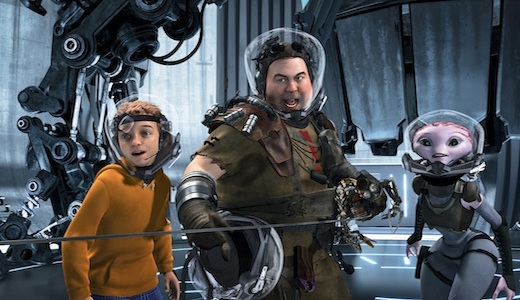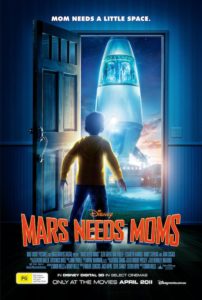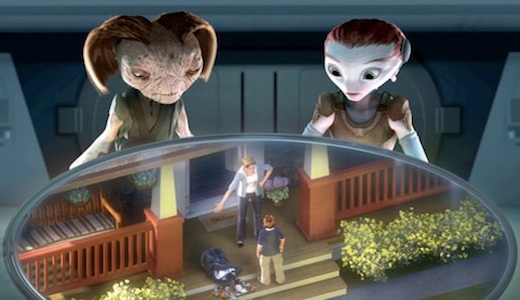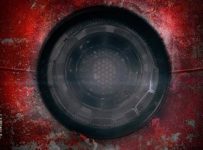Being the great-grandson of author H.G. Wells is a tough act to follow, with “The Time Machine” perhaps the most seminal time travel story of all time. Indeed, Simon Wells was last seen behind the camera retelling of his great-grandfather’s for the screen.
Wells the younger has challenged the animation giant Disney with his first feature as a director, the animated American Tail: Fieval Goes West. It was easily beaten by Disney’s Beauty and the Beast, and subsequent films Balto and We’re Back: A Dinosaur’s Story were similarly maligned by critics. His most successful film (Prince of Egypt) was narratively crippled by its attempts to appease at least three major religious groups simultaneously. After almost a decade away from the director’s chair, Wells has returned to the big chair with Mars Needs Moms.
A disobedient boy, Milo (Seth Green, voice-over by Seth Dusky) thinks that his life would be better off without his nagging mother (Joan Cusack, Toy Story 3) around. However, when Martians kidnap her, as part of an elaborate scheme to distill Earth’s intrinsic ‘momness’, Milo is determined to rescue her. Aided only by the rotund tech-savvy fellow Earthman Gribble (Dan Fogler, Love Happens) and the rebellious hippie Martian Ki (Elisabeth Harnois, A Single Man), Milo must fight his way through Martian HQ and save his mum…er…mom.
Motion capture technology (or ‘mo-cap’) has come a long way in the last few years, highlighted in the Lord of the Rings trilogy with the groundbreaking Gollum, but pushed along by executive producer Robert Zemeckis and Image Movers Digital’s films The Polar Express, Beowulf and A Christmas Carol. As stunning as this animation looks, especially in the wonderful world it recreated in the Dickens tale, one criticism is that the style can look a little unnatural. Mars Needs Moms often wanders into Uncanny Valley, a term coined by roboticist Masahiro Mori to describe the point where an artificial creation looks so realistic it causes revulsion. This is especially true of Milo’s mother, who resembles Joan Cusack just enough that’s its freaky.
The animation excels when it is used with the Martians, creating naturalistic movement out of otherworldly creatures and fully selling the alien world. Yet this raises the bigger question of whether ‘natural’ is something that animation should be doing. The beauty of animated films is that they can take us places and show us things that don’t exist in the real world, and to try and recreate human action seems to be counter to the spirit of that craft. Despite the alien world that Mars Needs Moms necessarily belongs to, the mo-cap work grounds the film when it should be celebrating the insanity of it all.
The acting, however, is top notch. Weeks of work in the mo-cap suits ensure that every nuance in the fine cast’s performances are translated onto the screen and, with the exception of Seth Green (whose voice was replaced by the younger Seth Dusky), it’s the next best thing to sticking a camera in front of the actors. Indeed, it is all visually quite stunning, especially if you have been lucky enough to catch this in IMAX 3D. Despite the odd freaky looking humans, there are moments when the vistas are simply breathtaking. Narratively, the film doesn’t break much new ground, and Wells replacing Zemeckis means that there is no skilled director of performances guiding the events behind the scenes.
Although the story may be derivative of The Twilight Zone-style shows and various after-school specials, there is still a spirit of adventure at the heart of Mars Needs Moms that will illicit giggles from the younger members of the audience (but not too young, especially given some darker turns the film takes). Perhaps one of the few saving graces of the lack of success of this film is that it may have put the kibosh on Zemeckis’ planned remake of The Beatles’ Yellow Submarine.
Another impressive piece of technical filmmaking from Image Movers Digital, although the uncanny human recreations and the sometimes dark storyline may mean that this will struggle to find an audience. However, there is still much to enjoy in this alien fun-fest.
Mars Needs Moms was released in Australia on 14 April 2011 by Walt Disney Studios.







I had considered those issues of career vs. domesticity in thinking about this review, but I wasn’t sure if the issue was so cut and dry. The resolution (SPOILERS maybe?) is a suggestion of a ‘best of both worlds’. It seems to me more of a cautionary tale about letting technology replace human (or in this case Martian) interaction. Yet I do take your point on one level: if the ideal is the nuclear unit, does that make other families lesser? Perhaps ‘Lilo & Stitch’ got it right in their assessment of the “dysfunctional” family: “Is little, and broken, but still good. Yeah, still good.”